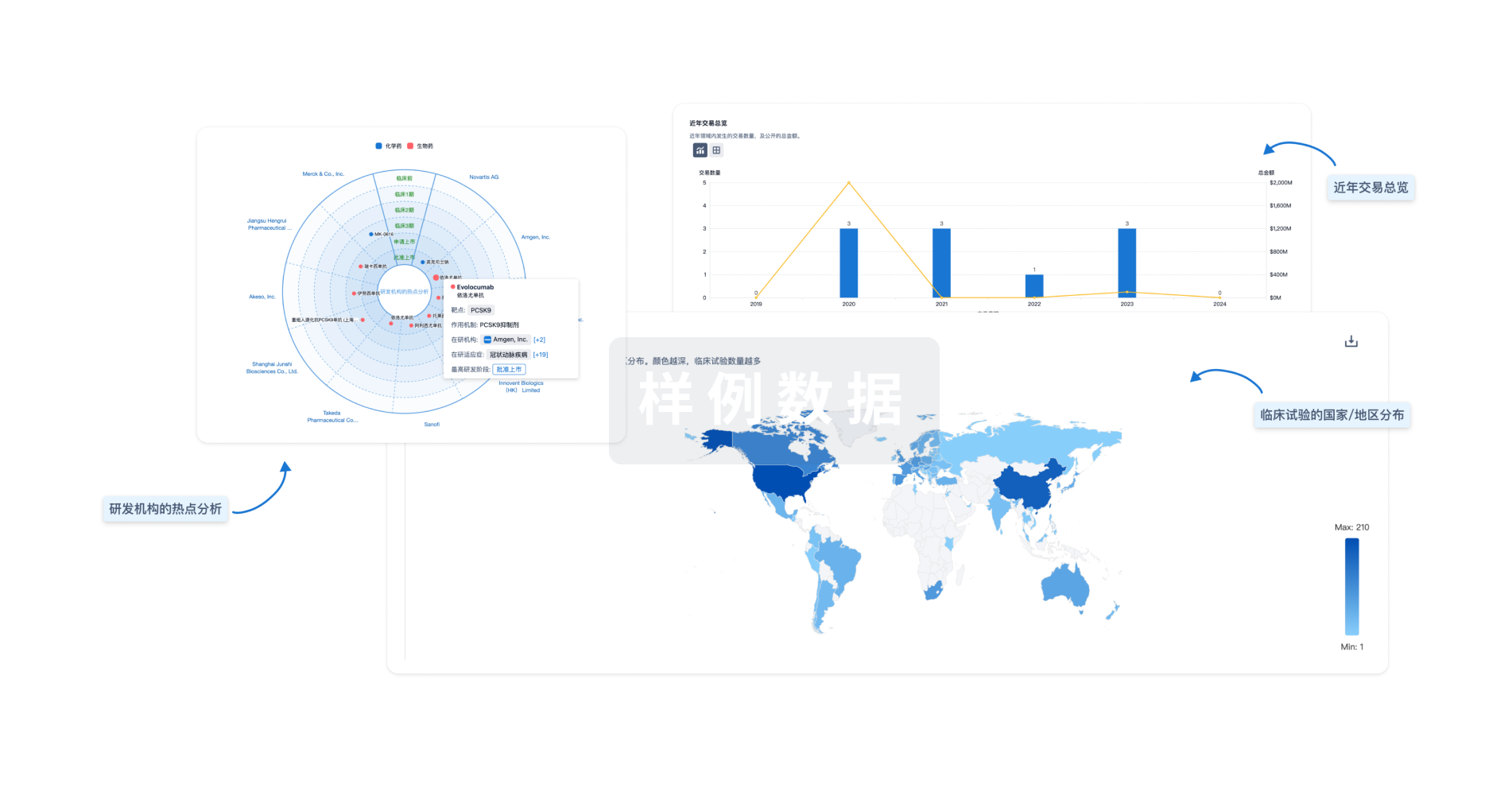预约演示
更新于:2025-05-07
SP2
更新于:2025-05-07
基本信息
别名 KIAA0048、SP2、Sp2 transcription factor + [1] |
简介 Binds to GC box promoters elements and selectively activates mRNA synthesis from genes that contain functional recognition sites. |
关联
1
项与 SP2 相关的药物CN117700537
专利挖掘靶点 |
作用机制- |
在研适应症 |
非在研适应症- |
最高研发阶段药物发现 |
首次获批国家/地区- |
首次获批日期1800-01-20 |
100 项与 SP2 相关的临床结果
登录后查看更多信息
100 项与 SP2 相关的转化医学
登录后查看更多信息
0 项与 SP2 相关的专利(医药)
登录后查看更多信息
254
项与 SP2 相关的文献(医药)2025-12-31·Emerging Microbes & Infections
Mechanisms underlying delayed loss of HBeAg and HBV DNA following HBsAg seroclearance in PEG-IFNα treated patients of chronic hepatitis B
Article
作者: Jiang, Bei ; Li, Minghui ; Cao, Zhenhuan ; Chen, Xiangmei ; Guan, Guiwen ; Zhao, Kaitao ; Lu, Fengmin ; Guo, Yifei ; Gu, Zhiqiang ; Xia, Yuchen ; Zhang, Jiming ; Wang, Lin ; Gu, Weilin ; Yuen, Man-fung
2025-08-01·Neuropharmacology
A putative binding model of nitazene derivatives at the μ-opioid receptor
Article
作者: Clayton, Joseph ; Shen, Jana ; Skiniotis, Georgios ; Shi, Lei ; Robertson, Michael J ; Stavitskaya, Lidiya ; Michaelides, Michael
2025-07-01·Journal of Virological Methods
High-dimensional droplet digital PCR of multiple hepatitis B splice variants in serum, liver, and tissue culture
Article
作者: Sulkowski, Mark S ; Grudda, Tanner ; Lo, Che-Min ; Skinner, Nicole E ; Balagopal, Ashwin ; Jiang, Chenkai ; Thio, Chloe L
4
项与 SP2 相关的新闻(医药)2025-02-13
·生物世界
编辑丨王多鱼
排版丨水成文
癌细胞在肿瘤发生过程中会积累大量突变,这些突变在癌症的发生和发展中扮演着至关重要的角色。它们不仅可以推动癌症的启动、进展和维持,还能促进癌细胞的扩散与转移。研究基因组突变不仅帮助我们更好地理解癌症的生物学机制,还为开发新的治疗方法提供重要线索。
癌症驱动突变的类型多种多样,从点突变到大规模的染色体重排,涵盖了基因组的编码区和非编码区。点突变在各种癌症中是非常重要的驱动突变类型。大规模的基因组研究显示,单个肿瘤通常会获得 2-8 个驱动突变,其中大多数是点突变。这些点突变在癌症的发生和发展中发挥着关键作用。有趣的是,在编码区的点突变中,大约 25-30% 是同义突变,这些突变虽然不会改变蛋白质的氨基酸序列,但它们在致癌过程中的潜在作用仍有许多未知之处。癌症细胞在肿瘤形成过程中会积累大量突变,包括这些看似“无害”的同义突变。
近年来的大量研究表明,表观转录组修饰,尤其是 RNA 的 N6-甲基腺苷(m6A)修饰,在癌症的发生和发展中发挥关键作用。m6A 修饰的动态变化影响 RNA 的稳定性、剪接、翻译和转运等过程,且受到蛋白“writers”、“erasers”和“readers”(WER)共同调控。m6A WER 的失调在多种癌症类型中广泛存在。举例而言,m6A 的“writer” METTL3 在急性髓系白血病(AML)中异常高表达,通过增强 MYC、BCL2、PTEN、SP1 和 SP2 等 mRNA 的翻译,促进白血病的发展。m6A 的“reader” YTHDF2 在胶质母细胞瘤中高表达,促进细胞增殖、侵袭和肿瘤发生,与胶质瘤患者的不良预后相关。这些研究表明,m6A 修饰机制的失调对肿瘤的发生有显著影响。然而,基因组突变是否直接调控 mRNA m6A 修饰,仍需进一步研究。
2025 年 2 月 13 日,西湖大学生命科学学院、西湖实验室谢琦团队、窦岩梅团队及浙江大学爱丁堡大学联合学院陈迪团队合作,在国际顶尖学术期刊 Cell 上发表了题为:Synonymous mutations promote tumorigenesis by disrupting m6A-dependent mRNA metabolism 的研究论文。
该研究通过对于人类泛癌基因组突变进行了系统的质控与梳理,发现并验证了一类可以通过直接破坏 mRNA m6A 修饰位点从而促进肿瘤发生发展的新型同义突变——同义m6A破坏突变(synonymous m6A Disruption Mutations,sm6A-DM)。
该研究发现了同义突变与表观转录组的直接联系,揭示了一种全新的肿瘤发生发展的调控机制,为肿瘤的精准医疗和靶向用药提供了新思路。此外,该研究还拓展了我们对于生命科学“中心法则”的理解——基因组 DNA 序列还可以通过直接影响 mRNA 的修饰对其进行精细调控。
整合癌症基因组数据库与 m6A 修饰数据库,发现人类癌症中的潜在 m6A-DM
研究团队首先整合了最新的 COSMIC 数据库与 TCGA 数据,对人类泛癌基因组突变进行了系统的质控与梳理,并收集整理了最新的人类 m6A 数据(m6A-Atlas v2.0和 REPIC数据库等)。然后通过三种严格的筛选过滤标准(图1,包括突变可重复性筛选,满足m6A数据覆盖,以及更进一步的可靠性筛选)得到了人类基因组中的 12849 个潜在的 m6A Disruption Mutations(m6A-DM)。这些 m6A-DM 可以进一步分为同义突变(sm6A-DM)和错义突变(mm6A-DM)。研究团队发现,sm6A-DM 更容易发生在抑癌基因(tumor suppressor gene)中。
图1. m6A-DM的鉴定流程与基因分布特征
发现并验证关键抑癌基因的 sm6A-DM 的突变位点及功能
根据分析癌症基因组突变的发生频率,研究团队确定了两个排名最靠前的 sm6A-DM 位点:CDKN2A-c.A294B 和 BRCA2-c.A1365G,并对其展开了功能验证与机理探究。
为了验证这两个位点的功能,研究团队同时采用了实验室前期开发的 dCasRx 定点甲基化编辑系统和碱基定点敲入系统两种调控手段,分别在表观转录组修饰水平和基因组原位水平对高度关联的肿瘤类型细胞进行调控。实验结果表明,这两个位点的 m6A 修饰水平与对应基因转录本的丰度呈现正相关,当该位点的发生突变后,会破坏该位点的 m6A 修饰并影响mRNA稳定性,进而导致其相应基因的 mRNA 下调(图2)。
图2. sm6A-DM对mRNA稳定性的显著影响
此外,研究团队还发现,CDKN2A-c.A294B 突变在导致 CDKN2A 转录本以及蛋白水平丰度的显著下调后,加速了肿瘤细胞的分裂周期,从而增强了肿瘤细胞增殖以及在小鼠体内的成瘤速度,大大增加了该肿瘤的恶性程度。针对 BRCA2 的 sm6A-DM,考虑到 BRCA1 和 BRCA2 的缺陷使会使得癌细胞对聚腺苷二磷酸核糖聚合酶抑制剂(PARPi)更为敏感,而且临床上已经批准了 PARPi 用于 BRCA1 和 BRCA2 的缺陷的肿瘤治疗,该研究团队进一步检测了 FDA 批准的 PARPi 药物奥拉帕尼(Olaparib)对于具备 BRCA2-c.A1365G 突变的肿瘤细胞的治疗效果。
实验结果显示,具有 BRCA2-c.A1365G 突变的肿瘤细胞对 PARPi 药物 Olaparib 治疗更为敏感,并且对于具有该 sm6A-DM 突变的荷瘤小鼠采用 Olaparib 治疗,也得到了更好抑制肿瘤生长的效果。提示了BRCA2-c.A1365G 突变可能可以作为 PARPi 用药的新型标志物。
sm6A-DM调控肿瘤发生发展的假说
通过联系癌症基因组数据与表观转录组数据,研究团队揭示并定义了一类高发于抑癌基因(tumor suppressor gene)的同义突变(sm6A-DM),它们可以扰乱 mRNA 的正常 m6A 修饰,使得 mRNA 稳定性减弱,引起 mRNA 和蛋白丰度水平的改变,并改变肿瘤发生发展进程。图3 介绍了同义突变 sm6A-DM 调控肿瘤发生发展的假说。
图3. sm6A-DM在肿瘤发生发展过程中所扮演的角色
综上所述,该研究鉴定并表征了一类基因组同义突变——sm6A-DM。这些突变能破坏相应 mRNA 上的 m6A 修饰,导致基因表达的潜在失调,为肿瘤发生和发展的机制提供了新的见解。sm6A-DM 的发现揭示了分子生物学中心法则的一个先前未被重视的维度:DNA 突变可以直接决定 mRNA 的修饰模式。研究结果表明,基因突变与表观转录组变化之间存在着深刻的联系,这可能对各种疾病的诊断和治疗策略产生重要影响。
西湖实验室研究员谢琦博士、窦岩梅博士以及浙江大学爱丁堡大学联合学院陈迪博士为该论文的共同通讯作者。西湖实验室助理研究员蓝一恒、西湖大学生命科学学院博士生夏真和浙江大学爱丁堡大学联合学院博士生邵奇哲为论文共同第一作者。该研究得到了国家自然科学基金、科技创新2030重大项目、浙江省“尖兵”和“领雁”研发计划和西湖教育基金会的资金支持。感谢西湖大学生命科学学院杨剑教授的讨论和建议。
西湖实验室研究员谢琦课题组一直从事肿瘤的靶向和免疫治疗研究,取得了一系列的研究成果,研究成果以通讯作者身份发表在 Cell、Nature Biomedical Engineering、Cancer Discovery、Immunity 等国际著名学术期刊,详情见实验室主页:https://xieqi.lab.westlake.edu.cn/。欢迎优秀人才加入我们的研究团队推动相关课题。有意者可以联系谢琦博士(xieqi@westlake.edu.cn)。
论文链接:
https://doi.org/10.1016/j.cell.2025.01.026
设置星标,不错过精彩推文
开放转载
欢迎转发到朋友圈和微信群
微信加群
为促进前沿研究的传播和交流,我们组建了多个专业交流群,长按下方二维码,即可添加小编微信进群,由于申请人数较多,添加微信时请备注:学校/专业/姓名,如果是PI/教授,还请注明。
点在看,传递你的品味
信使RNA
2024-12-26
·乐威医药
——背景——
蛋白质与核酸、小分子、多肽以及金属等配体的相互作用对生物功能至关重要,但原子级别建模这些相互作用并预测其构象系综仍然面临较大挑战。已有的基于深度学习的结构预测工具通常针对特定类别的相互作用进行建模,这限制了对不同功能蛋白质的通用建模,同时这些方法对分子的输入特征因输入分子的类型而异,一定程度上限制了网络学习一般物理化学原理的能力。
为解决上述挑战,David Baker课题组开发了用于蛋白质-配体相互作用的全原子级建模网络ChemNet [1]。作者认为,要实现对蛋白质与各种类型配体结合构象的通用预测方法,需要实现对配体与蛋白质口袋原子的统一建模,这样有希望捕捉到本质的物理化学信息,实现在不同的结合状态,都能准确描述构象系综。这样的统一建模必须在全原子级别上进行。在原子级别上,在以往的以蛋白质为主的模型如AlphaFold系列、RoseTTAFold等中使用的进化信息与结构的相关性较小,因此,作者认为从蛋白序列生成构象系综不合适,应以结合位点或催化口袋周围的蛋白质主链的坐标,以及小分子、侧链的键连几何结构为起点。与蛋白质相互作用的小分子和氨基酸侧链的键合几何的原子级描述。这样的模型虽然无法从序列预测结构,但对于模拟小分子或结合肽的构象以及蛋白质结合位点和相互作用侧链的构象非常有用。
对整个复合物进行全原子级建模势必会导致体系过大而难以计算,作者认为,由于蛋白质的结构可以从PDB获取,或者用AF2或RF生成,可靠的蛋白质主链结构是较容易获得的。在已知结合位点(或相互作用区域)的情况下,此时的任务就是将配体对接到结合位点,调整蛋白质侧链和配体分子本身的构象。ChemNet将学习问题框定为结构去噪任务,在已知系统的所有化学(原子、成键)信息的前提下,从打乱的原子坐标重新生成结合构象。比如,在蛋白质-小分子对接的体系中,网络的输入包括蛋白质主链坐标、氨基酸序列和其侧链坐标(这些侧链的原子坐标会在Cα原子周围随机初始化),以及小分子的化学结构(原子坐标在分子中随机原子周围随机初始化),通过去噪过程生成预测的结合构象,并通过多次构象生成构象系综。作者将ChemNet应用在酶活性中心设计中,取得了较好的效果。
——模型架构——
如图1所示,在模型输入中,所有类型的分子都用图来表示化学结构,节点代表重原子,边代表化学键。节点特征包含原子类型、初始3D坐标等信息。同时传入手性中心的信息,用一个4维向量描述3个原子绕手性中心顺时针排列的顺序。对于sp2碳,则用另一个feature描述sp2平面中心和相邻的三个原子。
ChemNet的网络架构借鉴了RoseTTAFold,使用了1D、2D、3D的三轨架构(图1D)。在将输入映射到1D、2D、3D嵌入(embedding)后,这3个嵌入被输入到迭代去噪模块,在对坐标去噪,输出3D构象以及构象的置信区间。
图1. ChemNet的网络架构
在迭代模块(图2)中,首先对每个原子,基于空间距离选32个邻居构建原子邻接图,由图中的原子成对信息通过一个前馈层计算bias,来对2D嵌入计算attention,更新2D嵌入。然后使用一个SE3-Transformer网络,输出3D构象和1D嵌入。
图2. 迭代模块的架构
输入包含5部分(图3):1. 3D构象,即各原子坐标;2. 键分离邻接图,包含每个原子最近的16个成键邻居(图距离最近)和16个非成键邻居(空间最近)的信息;3. 1D嵌入;4. 2D嵌入;5. 键长、手性中心张角和sp2平面角的几何损失函数对原子坐标的梯度。根据更新的结构,重新计算原子邻接图并更新2D嵌入。之后在1D和2D轨分别接有原子和原子对(距离矩阵)的置信度预测头。最后对1D和2D嵌入进行残差连接。整个网络进行8次迭代,共享权重。
图3. 结构更新模块
模型训练的loss是由坐标预测偏差和置信度预测偏差组合而成的(图4)。坐标偏差包含键长、键角、手性中心张角、sp2平面角几项的偏差,和3个全原子FAPE loss。FAPE loss最初是在Alphafold2模型中用于蛋白质结构预测的,在这里修改为了对全原子体系计算坐标偏差。计算方法是:对成键的3原子组ijk,构建一个三维坐标系(如图5,基矢方向是平面法向量、三角形的一条边和其高,原点是高穿过的顶点),称为一个frame,在此坐标系下计算各个原子在预测构象和参考构象中的坐标偏差,对原子取平均值;再对每个frame计算平均偏差,对frame平均,得到FAPE。Interaction和small molecule FAPE则分别指对每个蛋白侧链的frame计算小分子的原子偏差以及只对小分子计算FAPE,使得训练过程更关注于配体构象的准确。
图4. 损失函数
图5. FAPE loss计算的示意图
置信度偏差中,plDDT即Alphafold2的plDDT函数,由对蛋白残基计算修改为对每个重原子计算;pRMSD为全原子RMSD的预测值;pDE是原子距离矩阵的预测偏差。
——模型训练——
为了验证网络架构能够处理各种化学结构,作者用剑桥结构数据库(Cambridge Structural Database, CSD),对模型在小分子构象预测任务上进行训练。训练任务是基于其化学结构和随机初始化的起始坐标,预测小分子的构象。在CSD结构上训练ChemNet分为两个阶段:第一阶段在模型中串联了四个迭代模块,并且仅采用全原子 FAPE 作为损失项;第二阶段将迭代次数增加到八个,并增加了成键原子几何损失项(键长、键角、手性中心张角、平面角)以提升预测结构的局部质量(如图2B和C中红色与紫色所示)。对照实验表明(图6),将迭代次数减少到2次或用坐标和距离RMSD损失的组合替代FAPE,都会导致预测质量显著下降(如图2B和C中橙色和蓝色所示)。此外,当2D输入不包含键分离特征(一个整数,计算化学结构图中任意两个原子之间间隔的共价键的数量)而用一个0-1的特征表征两个原子是否属于同一个分子(即:能通过共价键构成的路径从原子A找到原子B)时,性能也会降低。训练完的ChemNet成功地准确生成了含有50多个原子的复杂大环化合物的三维结构。
图6. 模块必要性验证
而后,作者使用PDB(Protein Data Bank)中的蛋白质小分子复合物,对模型在复合物构象预测任务上进行训练。作者对PDB中的蛋白质小分子复合物进行了一定的筛选,去除了分辨率低(>2.5Å)、未解出原子多(>10%)、非标准残基多(>20%)以及所含小分子与设定的测试集中小分子过于相似(Tanimoto similarity > 80%)的结构,留下了近12万个结构作为训练和验证集。为了让模型学习分子在界面上的物理化学信息,这些结构中,只有水被移除,其他的如小分子、共价修饰、金属离子、核酸等都被保留。测试集为复合物结构预测任务是,在骨架原子位置不动的情况下,预测侧链原子和小分子的原子坐标。因为ChemNet用去噪过程来生成坐标,需要一个打乱的初始坐标,这里它的初始坐标是这样设置的:首先在结合位点附近随机选定一个原子截断中心,这个中心选定为小分子原子、蛋白原子、核酸原子、金属离子的概率比例为5:1:1:1,在截断中心空间距离最近(根据PDB结构算)的600个原子被选定,其他原子不动。选定的600原子,对骨架(蛋白质主链、核酸的磷酸-核糖链)原子,仅加σ为0.1Å的高斯噪声;对侧链原子,先坍缩到其相连的主链原子,然后加一个σ=1.5Å的高斯噪声;对小分子,会随机选其中一个原子,给坐标加一个σ=1.5Å的高斯噪声,然后所有其他原子坍缩到新坐标,也加同样噪声。由此获得一个骨架和小分子整体位置基本不动,但侧链和小分子的具体原子坐标打乱的结构。
图7. 模型在复合物构象预测任务的结果
由于大部分原子坐标被打乱,ChemNet的坐标生成不太依赖于初始构象(骨架坐标受影响较大);在结构生成的案例中,如图7的B、C、D、E(上下分别是heme和cortisol与蛋白质的复合物),从降维图(图7D)中看到,生成模型的采样基本能覆盖结合位点的构象空间;图7E展示了RMSD预测的结果,作者任务在生成较好的构象中,模型预测的RMSD是可以给构象RMSD较好地排序。不过,似乎pRMSD区分预测准确和不准确(RMSD特别大)构象的能力不是那么强。作者使用的测试集包含65个药物靶标蛋白的非天然药物结合构象,每个靶标都有一个天然小分子共晶结构,和若干非天然小分子共晶结构,数据集共含有1112个非天然结构。作者希望用从非天然结构预测来说明模型对不同小分子复合物构象预测的泛化性。测试结果展示在图7F和图7G。在图7F中,灰色虚线表示在不同的构象采样数量下,采样到的构象中RMSD的最小值<2Å的体系比例;橙色线表示用pRMSD值排序,排名最高构象RMSD<2Å的体系比例。可以看到用pRMSD排序,能找到大约75%预测准确的构象。图7G展示的是对接成功率,亮条是以RMSD<1Å为对接成功的标准,灰暗条是以RMSD<2Å为标准。可以看到,pRMSD的对接能力比其他置信度指标强;而与当前表现最好的RoseTTA GALigandDock相比,ChemNet在RMSD<2Å标准下表现稍好,但RMSD<1Å下表现较差。使用通用Rosetta力场对网络生成的对接构象进行最小化,并估算结合自由能来挑选构象,在<2 Å时没有显著变化,在<1 Å时对接成功率提高了7.3%,接近于GALigandDock。作者认为,虽然ChemNet在对接能力上没有超越GALigandDock,这仍是一个值得注意的表现,因为ChemNet对蛋白复合物体系统一建模,包含了复合物中除水外的所有分子,没有专门对非天然复合物的对接任务进行训练;且ChemNet直接从噪声生成构象,其他方法的结果受到初始构象的影响。
——应用——
作者将ChemNet在复合物构象系综预测上的能力,利用在酶设计领域,取得了较好的效果。
在从头设计酶中,除了靶标的主链结构,关键催化侧链和反应底物的结合构象也至关重要。关键侧链的官能团与底物或过渡态之间的氢键和静电相互作用,对催化至关重要,由于氢键对距离和键角非常敏感,距离的0.5Å偏差和键角的30°偏差就可对氢键解离能产生很大影响,因此对构象预测精度的要求相当高。预组织(preorganization)是天然酶活性位点的重要特征,它指即便底物不存在,催化口袋中残基侧链也应保持形成氢键、静电作用等相互作用时的位置,这样酶结合底物时的熵损失小,并且催化残基位置能确保与底物或过渡态以正确的姿势结合。因此在酶设计时,需要评估活性位点的预组织性。过去的方法如Rosetta Rotamer Bolzmann,对侧链使用了转子(rotamer)近似,且对蛋白和小分子分别采样构象,无法考虑侧链移动与小分子运动的耦合。作者希望用ChemNet克服这一限制,达到在远小于MD模拟的运行时间下,获得比Rotamer Boltzmann更准确考虑侧链与小分子运动耦合的预组织性预测。RA95系列的逆羟醛缩合酶(retro-aldolase),含有一系列天然版本和定向进化改造的版本(图8B,这些版本的酶都有高分辨率的晶体结构),其催化羟醛缩合逆反应的机理如图8A,核心催化残基是活性位点的Lys。作者分析,中间体1和2涉及的基元反应活化能较高,是反应决速步,如果酶能稳定这些中间体,则可提高反应速率。作者用ChemNet预测了不同版本的RA95酶的催化口袋与中间体1、2的结合构象(图8C),考察模型给出的pRMSD,pRMSD越小,说明侧链位置预组织性越高。结果中,活性低的版本pRMSD都较大,越小的酶活性越高,这表明预组织性低是早期酶设计工作的一个主要缺点,MD模拟给出了类似的结果。由此说明,ChemNet可以快速评估酶活性位点的预组织性,指导酶设计工作。
图8. 逆羟醛缩合酶的预组织性预测、活性及设计
此外,作者还前瞻性地测试了ChemNet在指导蛋白质设计中的使用,以深度学习生成的NTF2样折叠为骨架进行了一轮全新的逆醛缩酶设计。NTF2样折叠此前成功地生成出高活性的新型荧光素酶。设计的步骤包括:NTF2样折叠骨架生成;识别潜在催化活性位点;理论酶(theozyme)安装;打分筛选酶设计;实验验证。全新的酶设计首先需要确定理论酶(theozyme),即过渡态(或中间体)被酶活性位点的官能团通过相互作用稳定的结构。作者使用活性最高的RA95逆醛缩酶的活性中心,作为理论酶(如图S3)进行后续设计。作者推测ChemNet可能能通过对预组织性的预测,辅助挑选酶设计(设计出的酶)。
图9. 理论酶设计
首先作者使用RoseTTAFold joint inpainting(RFjoint2)生成大量NTF2样折叠骨架,接下来需要将理论酶“安装”到骨架的合适位置。作者使用修改过的XML-Matcher确定骨架中的哪些位置能在几何形状上容纳与中间体相互作用的4个残基,得到一系列用于匹配理论酶与骨架位置的约束文件。然后将频繁出现在不同骨架中的理论酶与骨架位置的组合应用到10000个NTF2样骨架中,用LigandMPNN在有底物的条件下生成剩余的骨架序列。用Alphafold2验证序列结构,选出iDDT值高的序列进入下一步。接下来需要评估这些设计序列是否有高催化活性,作者使用一组理论酶中侧链极性原子之间的距离“nuc(NZ)” - “brd(OE1)”、“sup(OH)” - “brd(NE2)”、“nuc(NZ)” - “sht(OH)”来衡量氢键网络的形成,在能形成氢键网络的酶设计中,评估酶的预组织性来筛选酶设计。作者提出了两个策略:(1)naive策略:计算在“由AlphaFold2预测的结构”与“LigandMPNN设计的结构中”理论酶侧链重原子的RMSD。选取侧链极性原子间距在2.0-3.3Å的酶设计,按照侧链重原子RMSD排序,筛选出RMSD最小的90个酶,对这些设计用体外转录翻译系统(IVTT)测试活性。(2)ChemNet策略:以AlphaFold2预测的酶蛋白构象作为骨架结构,使用ChemNet生成50个复合物构象,并预测置信度;选取理论酶侧链的极性原子平均间距在2.0-3.3Å的酶设计,根据侧链极性原子pRMSD筛选设计,用IVTT测试活性。
由IVTT结果(图10,列出的设计为分别为两种策略筛选出的top 12设计,control组为已知的酶)可以看出,ChemNet策略筛选出来的酶设计活性显著高于naive策略。其中活性最高的酶,kcat/Km = 11,249.4 M-1min-1,活性与近期使用RFdiffusion 加 proteinMPNN设计的酶相当,远高于定向进化前早期的酶设计,该酶被命名为cnRA-50(图8D)。作者用ChemNet预测cnRA-50与其他设计的step1与step2结合构象的预组织性(图8E, F),发现活性最高的酶活性中心的侧链pRMSD显著小于无活性蛋白(图8G)。
图10. 两种评估策略筛选结果的活性对比
——总结——
ChemNet用统一的全原子建模,实现了在给定蛋白质序列和主链原子位置的情况下,生成任意分子的构象集合,包括单独的分子和蛋白质复合物。在主链基本固定的场景下,它相比与Alphafold3、RoseTTAFold All-Atom等其他蛋白质结构预测方法,计算速度大大加快,从而能生成构象系综。统一的全原子建模,适用于所有类型分子的相互作用,便于扩展到生物分子之外的其他复杂的小分子。ChemNet快速生成蛋白质-小分子复合物构象系综的能力,对于计算酶设计和小分子结合位点设计工作具有相当的实用性:可以轻松评估活性位点的结构精度,以及关键催化/相互作用侧链基团的预组织程度。作者在全新逆醛缩酶的设计中使用ChemNet生成构象系综进行筛选,其活性远高于此前的设计。作者预计,基于ChemNet的构象系综生成将广泛用于预测复杂非蛋白质分子及其蛋白质复合物结构,并普遍地应用于评估酶和蛋白质-小分子结合位点设计。
参考文献:
[1] Ivan Anishchenko, Yakov Kipnis, Indrek Kalvet, Guangfeng Zhou, Rohith Krishna, Samuel J Pellock, Anna Lauko, Gyu Rie Lee, Linna An, Justas Dauparas, Frank DiMaio, David Baker, Modeling protein-small molecule conformational ensembles with ChemNet, bioRxiv, 2024, DOI:10.1101/2024.09.25.614868.
作者:凌心辽
审稿:王宇哲
编辑:王宇哲
版权声明:本文内容及图片,如有侵权请联系删除。
免责声明:本文内容仅作信息交流学习,并不反映任何意见及观点。
往期推荐
乐威医药(欧洲)分公司正式成立
乐威医药沧州GMP生产基地高活生产线启用
乐威医药亮相意大利CPHI Milan 2024
2024-12-23
——背景——
蛋白质与核酸、小分子、多肽以及金属等配体的相互作用对生物功能至关重要,但原子级别建模这些相互作用并预测其构象系综仍然面临较大挑战。已有的基于深度学习的结构预测工具通常针对特定类别的相互作用进行建模,这限制了对不同功能蛋白质的通用建模,同时这些方法对分子的输入特征因输入分子的类型而异,一定程度上限制了网络学习一般物理化学原理的能力。
为解决上述挑战,David Baker课题组开发了用于蛋白质-配体相互作用的全原子级建模网络ChemNet [1]。作者认为,要实现对蛋白质与各种类型配体结合构象的通用预测方法,需要实现对配体与蛋白质口袋原子的统一建模,这样有希望捕捉到本质的物理化学信息,实现在不同的结合状态,都能准确描述构象系综。这样的统一建模必须在全原子级别上进行。在原子级别上,在以往的以蛋白质为主的模型如AlphaFold系列、RoseTTAFold等中使用的进化信息与结构的相关性较小,因此,作者认为从蛋白序列生成构象系综不合适,应以结合位点或催化口袋周围的蛋白质主链的坐标,以及小分子、侧链的键连几何结构为起点。与蛋白质相互作用的小分子和氨基酸侧链的键合几何的原子级描述。这样的模型虽然无法从序列预测结构,但对于模拟小分子或结合肽的构象以及蛋白质结合位点和相互作用侧链的构象非常有用。
对整个复合物进行全原子级建模势必会导致体系过大而难以计算,作者认为,由于蛋白质的结构可以从PDB获取,或者用AF2或RF生成,可靠的蛋白质主链结构是较容易获得的。在已知结合位点(或相互作用区域)的情况下,此时的任务就是将配体对接到结合位点,调整蛋白质侧链和配体分子本身的构象。ChemNet将学习问题框定为结构去噪任务,在已知系统的所有化学(原子、成键)信息的前提下,从打乱的原子坐标重新生成结合构象。比如,在蛋白质-小分子对接的体系中,网络的输入包括蛋白质主链坐标、氨基酸序列和其侧链坐标(这些侧链的原子坐标会在Cα原子周围随机初始化),以及小分子的化学结构(原子坐标在分子中随机原子周围随机初始化),通过去噪过程生成预测的结合构象,并通过多次构象生成构象系综。作者将ChemNet应用在酶活性中心设计中,取得了较好的效果。
——模型架构——
如图1所示,在模型输入中,所有类型的分子都用图来表示化学结构,节点代表重原子,边代表化学键。节点特征包含原子类型、初始3D坐标等信息。同时传入手性中心的信息,用一个4维向量描述3个原子绕手性中心顺时针排列的顺序。对于sp2碳,则用另一个feature描述sp2平面中心和相邻的三个原子。
ChemNet的网络架构借鉴了RoseTTAFold,使用了1D、2D、3D的三轨架构(图1D)。在将输入映射到1D、2D、3D嵌入(embedding)后,这3个嵌入被输入到迭代去噪模块,在对坐标去噪,输出3D构象以及构象的置信区间。
图1. ChemNet的网络架构
在迭代模块(图2)中,首先对每个原子,基于空间距离选32个邻居构建原子邻接图,由图中的原子成对信息通过一个前馈层计算bias,来对2D嵌入计算attention,更新2D嵌入。然后使用一个SE3-Transformer网络,输出3D构象和1D嵌入。
图2. 迭代模块的架构
输入包含5部分(图3):1. 3D构象,即各原子坐标;2. 键分离邻接图,包含每个原子最近的16个成键邻居(图距离最近)和16个非成键邻居(空间最近)的信息;3. 1D嵌入;4. 2D嵌入;5. 键长、手性中心张角和sp2平面角的几何损失函数对原子坐标的梯度。根据更新的结构,重新计算原子邻接图并更新2D嵌入。之后在1D和2D轨分别接有原子和原子对(距离矩阵)的置信度预测头。最后对1D和2D嵌入进行残差连接。整个网络进行8次迭代,共享权重。
图3. 结构更新模块
模型训练的loss是由坐标预测偏差和置信度预测偏差组合而成的(图4)。坐标偏差包含键长、键角、手性中心张角、sp2平面角几项的偏差,和3个全原子FAPE loss。FAPE loss最初是在Alphafold2模型中用于蛋白质结构预测的,在这里修改为了对全原子体系计算坐标偏差。计算方法是:对成键的3原子组ijk,构建一个三维坐标系(如图5,基矢方向是平面法向量、三角形的一条边和其高,原点是高穿过的顶点),称为一个frame,在此坐标系下计算各个原子在预测构象和参考构象中的坐标偏差,对原子取平均值;再对每个frame计算平均偏差,对frame平均,得到FAPE。Interaction和small molecule FAPE则分别指对每个蛋白侧链的frame计算小分子的原子偏差以及只对小分子计算FAPE,使得训练过程更关注于配体构象的准确。
图4. 损失函数
图5. FAPE loss计算的示意图
置信度偏差中,plDDT即Alphafold2的plDDT函数,由对蛋白残基计算修改为对每个重原子计算;pRMSD为全原子RMSD的预测值;pDE是原子距离矩阵的预测偏差。
——模型训练——
为了验证网络架构能够处理各种化学结构,作者用剑桥结构数据库(Cambridge Structural Database, CSD),对模型在小分子构象预测任务上进行训练。训练任务是基于其化学结构和随机初始化的起始坐标,预测小分子的构象。在CSD结构上训练ChemNet分为两个阶段:第一阶段在模型中串联了四个迭代模块,并且仅采用全原子 FAPE 作为损失项;第二阶段将迭代次数增加到八个,并增加了成键原子几何损失项(键长、键角、手性中心张角、平面角)以提升预测结构的局部质量(如图2B和C中红色与紫色所示)。对照实验表明(图6),将迭代次数减少到2次或用坐标和距离RMSD损失的组合替代FAPE,都会导致预测质量显著下降(如图2B和C中橙色和蓝色所示)。此外,当2D输入不包含键分离特征(一个整数,计算化学结构图中任意两个原子之间间隔的共价键的数量)而用一个0-1的特征表征两个原子是否属于同一个分子(即:能通过共价键构成的路径从原子A找到原子B)时,性能也会降低。训练完的ChemNet成功地准确生成了含有50多个原子的复杂大环化合物的三维结构。
图6. 模块必要性验证
而后,作者使用PDB(Protein Data Bank)中的蛋白质小分子复合物,对模型在复合物构象预测任务上进行训练。作者对PDB中的蛋白质小分子复合物进行了一定的筛选,去除了分辨率低(>2.5Å)、未解出原子多(>10%)、非标准残基多(>20%)以及所含小分子与设定的测试集中小分子过于相似(Tanimoto similarity > 80%)的结构,留下了近12万个结构作为训练和验证集。为了让模型学习分子在界面上的物理化学信息,这些结构中,只有水被移除,其他的如小分子、共价修饰、金属离子、核酸等都被保留。测试集为复合物结构预测任务是,在骨架原子位置不动的情况下,预测侧链原子和小分子的原子坐标。因为ChemNet用去噪过程来生成坐标,需要一个打乱的初始坐标,这里它的初始坐标是这样设置的:首先在结合位点附近随机选定一个原子截断中心,这个中心选定为小分子原子、蛋白原子、核酸原子、金属离子的概率比例为5:1:1:1,在截断中心空间距离最近(根据PDB结构算)的600个原子被选定,其他原子不动。选定的600原子,对骨架(蛋白质主链、核酸的磷酸-核糖链)原子,仅加σ为0.1Å的高斯噪声;对侧链原子,先坍缩到其相连的主链原子,然后加一个σ=1.5Å的高斯噪声;对小分子,会随机选其中一个原子,给坐标加一个σ=1.5Å的高斯噪声,然后所有其他原子坍缩到新坐标,也加同样噪声。由此获得一个骨架和小分子整体位置基本不动,但侧链和小分子的具体原子坐标打乱的结构。
图7. 模型在复合物构象预测任务的结果
由于大部分原子坐标被打乱,ChemNet的坐标生成不太依赖于初始构象(骨架坐标受影响较大);在结构生成的案例中,如图7的B、C、D、E(上下分别是heme和cortisol与蛋白质的复合物),从降维图(图7D)中看到,生成模型的采样基本能覆盖结合位点的构象空间;图7E展示了RMSD预测的结果,作者任务在生成较好的构象中,模型预测的RMSD是可以给构象RMSD较好地排序。不过,似乎pRMSD区分预测准确和不准确(RMSD特别大)构象的能力不是那么强。作者使用的测试集包含65个药物靶标蛋白的非天然药物结合构象,每个靶标都有一个天然小分子共晶结构,和若干非天然小分子共晶结构,数据集共含有1112个非天然结构。作者希望用从非天然结构预测来说明模型对不同小分子复合物构象预测的泛化性。测试结果展示在图7F和图7G。在图7F中,灰色虚线表示在不同的构象采样数量下,采样到的构象中RMSD的最小值<2Å的体系比例;橙色线表示用pRMSD值排序,排名最高构象RMSD<2Å的体系比例。可以看到用pRMSD排序,能找到大约75%预测准确的构象。图7G展示的是对接成功率,亮条是以RMSD<1Å为对接成功的标准,灰暗条是以RMSD<2Å为标准。可以看到,pRMSD的对接能力比其他置信度指标强;而与当前表现最好的RoseTTA GALigandDock相比,ChemNet在RMSD<2Å标准下表现稍好,但RMSD<1Å下表现较差。使用通用Rosetta力场对网络生成的对接构象进行最小化,并估算结合自由能来挑选构象,在<2 Å时没有显著变化,在<1 Å时对接成功率提高了7.3%,接近于GALigandDock。作者认为,虽然ChemNet在对接能力上没有超越GALigandDock,这仍是一个值得注意的表现,因为ChemNet对蛋白复合物体系统一建模,包含了复合物中除水外的所有分子,没有专门对非天然复合物的对接任务进行训练;且ChemNet直接从噪声生成构象,其他方法的结果受到初始构象的影响。
——应用——
作者将ChemNet在复合物构象系综预测上的能力,利用在酶设计领域,取得了较好的效果。
在从头设计酶中,除了靶标的主链结构,关键催化侧链和反应底物的结合构象也至关重要。关键侧链的官能团与底物或过渡态之间的氢键和静电相互作用,对催化至关重要,由于氢键对距离和键角非常敏感,距离的0.5Å偏差和键角的30°偏差就可对氢键解离能产生很大影响,因此对构象预测精度的要求相当高。预组织(preorganization)是天然酶活性位点的重要特征,它指即便底物不存在,催化口袋中残基侧链也应保持形成氢键、静电作用等相互作用时的位置,这样酶结合底物时的熵损失小,并且催化残基位置能确保与底物或过渡态以正确的姿势结合。因此在酶设计时,需要评估活性位点的预组织性。过去的方法如Rosetta Rotamer Bolzmann,对侧链使用了转子(rotamer)近似,且对蛋白和小分子分别采样构象,无法考虑侧链移动与小分子运动的耦合。作者希望用ChemNet克服这一限制,达到在远小于MD模拟的运行时间下,获得比Rotamer Boltzmann更准确考虑侧链与小分子运动耦合的预组织性预测。RA95系列的逆羟醛缩合酶(retro-aldolase),含有一系列天然版本和定向进化改造的版本(图8B,这些版本的酶都有高分辨率的晶体结构),其催化羟醛缩合逆反应的机理如图8A,核心催化残基是活性位点的Lys。作者分析,中间体1和2涉及的基元反应活化能较高,是反应决速步,如果酶能稳定这些中间体,则可提高反应速率。作者用ChemNet预测了不同版本的RA95酶的催化口袋与中间体1、2的结合构象(图8C),考察模型给出的pRMSD,pRMSD越小,说明侧链位置预组织性越高。结果中,活性低的版本pRMSD都较大,越小的酶活性越高,这表明预组织性低是早期酶设计工作的一个主要缺点,MD模拟给出了类似的结果。由此说明,ChemNet可以快速评估酶活性位点的预组织性,指导酶设计工作。
图8. 逆羟醛缩合酶的预组织性预测、活性及设计
此外,作者还前瞻性地测试了ChemNet在指导蛋白质设计中的使用,以深度学习生成的NTF2样折叠为骨架进行了一轮全新的逆醛缩酶设计。NTF2样折叠此前成功地生成出高活性的新型荧光素酶。设计的步骤包括:NTF2样折叠骨架生成;识别潜在催化活性位点;理论酶(theozyme)安装;打分筛选酶设计;实验验证。全新的酶设计首先需要确定理论酶(theozyme),即过渡态(或中间体)被酶活性位点的官能团通过相互作用稳定的结构。作者使用活性最高的RA95逆醛缩酶的活性中心,作为理论酶(如图S3)进行后续设计。作者推测ChemNet可能能通过对预组织性的预测,辅助挑选酶设计(设计出的酶)。
图9. 理论酶设计
首先作者使用RoseTTAFold joint inpainting(RFjoint2)生成大量NTF2样折叠骨架,接下来需要将理论酶“安装”到骨架的合适位置。作者使用修改过的XML-Matcher确定骨架中的哪些位置能在几何形状上容纳与中间体相互作用的4个残基,得到一系列用于匹配理论酶与骨架位置的约束文件。然后将频繁出现在不同骨架中的理论酶与骨架位置的组合应用到10000个NTF2样骨架中,用LigandMPNN在有底物的条件下生成剩余的骨架序列。用Alphafold2验证序列结构,选出iDDT值高的序列进入下一步。接下来需要评估这些设计序列是否有高催化活性,作者使用一组理论酶中侧链极性原子之间的距离“nuc(NZ)” - “brd(OE1)”、“sup(OH)” - “brd(NE2)”、“nuc(NZ)” - “sht(OH)”来衡量氢键网络的形成,在能形成氢键网络的酶设计中,评估酶的预组织性来筛选酶设计。作者提出了两个策略:(1)naive策略:计算在“由AlphaFold2预测的结构”与“LigandMPNN设计的结构中”理论酶侧链重原子的RMSD。选取侧链极性原子间距在2.0-3.3Å的酶设计,按照侧链重原子RMSD排序,筛选出RMSD最小的90个酶,对这些设计用体外转录翻译系统(IVTT)测试活性。(2)ChemNet策略:以AlphaFold2预测的酶蛋白构象作为骨架结构,使用ChemNet生成50个复合物构象,并预测置信度;选取理论酶侧链的极性原子平均间距在2.0-3.3Å的酶设计,根据侧链极性原子pRMSD筛选设计,用IVTT测试活性。
由IVTT结果(图10,列出的设计为分别为两种策略筛选出的top 12设计,control组为已知的酶)可以看出,ChemNet策略筛选出来的酶设计活性显著高于naive策略。其中活性最高的酶,kcat/Km = 11,249.4 M-1min-1,活性与近期使用RFdiffusion 加 proteinMPNN设计的酶相当,远高于定向进化前早期的酶设计,该酶被命名为cnRA-50(图8D)。作者用ChemNet预测cnRA-50与其他设计的step1与step2结合构象的预组织性(图8E, F),发现活性最高的酶活性中心的侧链pRMSD显著小于无活性蛋白(图8G)。
图10. 两种评估策略筛选结果的活性对比
——总结——
ChemNet用统一的全原子建模,实现了在给定蛋白质序列和主链原子位置的情况下,生成任意分子的构象集合,包括单独的分子和蛋白质复合物。在主链基本固定的场景下,它相比与Alphafold3、RoseTTAFold All-Atom等其他蛋白质结构预测方法,计算速度大大加快,从而能生成构象系综。统一的全原子建模,适用于所有类型分子的相互作用,便于扩展到生物分子之外的其他复杂的小分子。ChemNet快速生成蛋白质-小分子复合物构象系综的能力,对于计算酶设计和小分子结合位点设计工作具有相当的实用性:可以轻松评估活性位点的结构精度,以及关键催化/相互作用侧链基团的预组织程度。作者在全新逆醛缩酶的设计中使用ChemNet生成构象系综进行筛选,其活性远高于此前的设计。作者预计,基于ChemNet的构象系综生成将广泛用于预测复杂非蛋白质分子及其蛋白质复合物结构,并普遍地应用于评估酶和蛋白质-小分子结合位点设计。
参考文献:
[1] Ivan Anishchenko, Yakov Kipnis, Indrek Kalvet, Guangfeng Zhou, Rohith Krishna, Samuel J Pellock, Anna Lauko, Gyu Rie Lee, Linna An, Justas Dauparas, Frank DiMaio, David Baker, Modeling protein-small molecule conformational ensembles with ChemNet, bioRxiv, 2024, DOI:10.1101/2024.09.25.614868.
作者:凌心辽
审稿:王宇哲
编辑:王宇哲
GoDesign
ID:Molecular_Design_Lab
( 扫描下方二维码可以订阅哦!)
分析
对领域进行一次全面的分析。
登录
或

Eureka LS:
全新生物医药AI Agent 覆盖科研全链路,让突破性发现快人一步
立即开始免费试用!
智慧芽新药情报库是智慧芽专为生命科学人士构建的基于AI的创新药情报平台,助您全方位提升您的研发与决策效率。
立即开始数据试用!
智慧芽新药库数据也通过智慧芽数据服务平台,以API或者数据包形式对外开放,助您更加充分利用智慧芽新药情报信息。
生物序列数据库
生物药研发创新
免费使用
化学结构数据库
小分子化药研发创新
免费使用